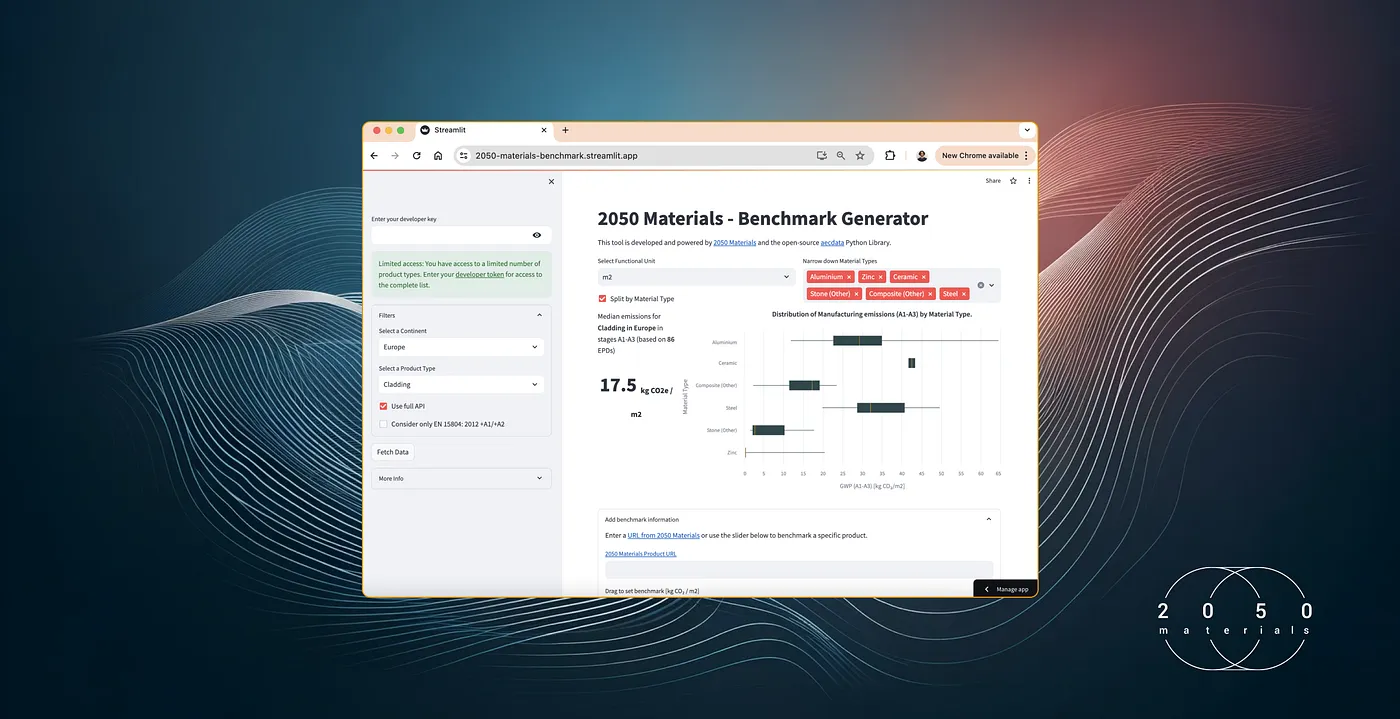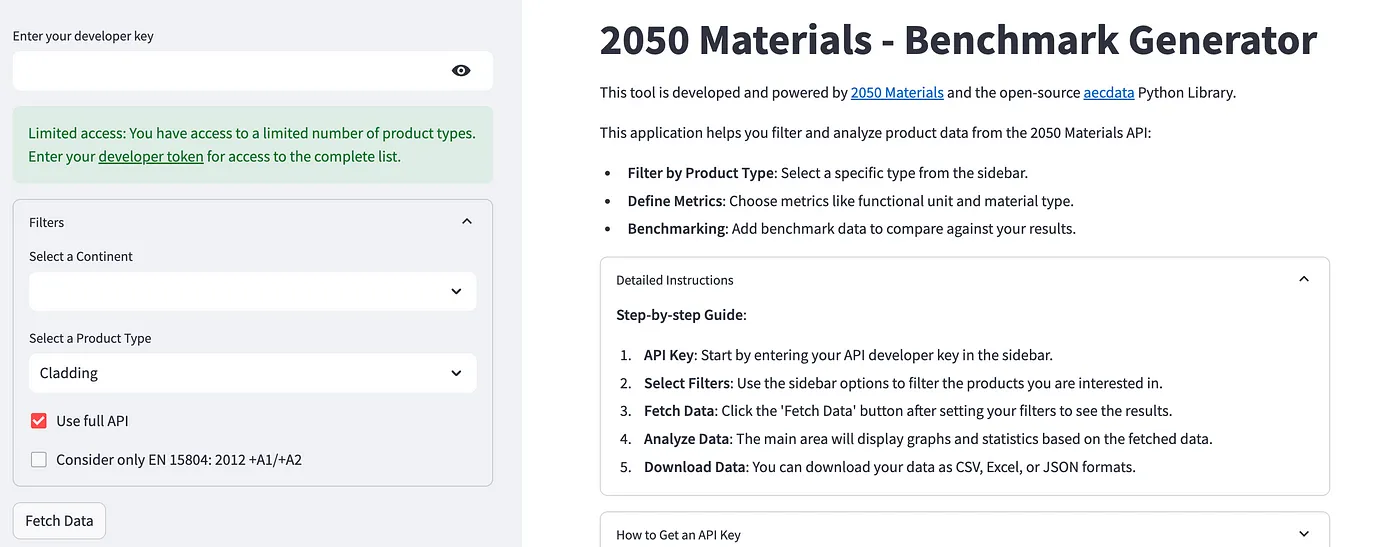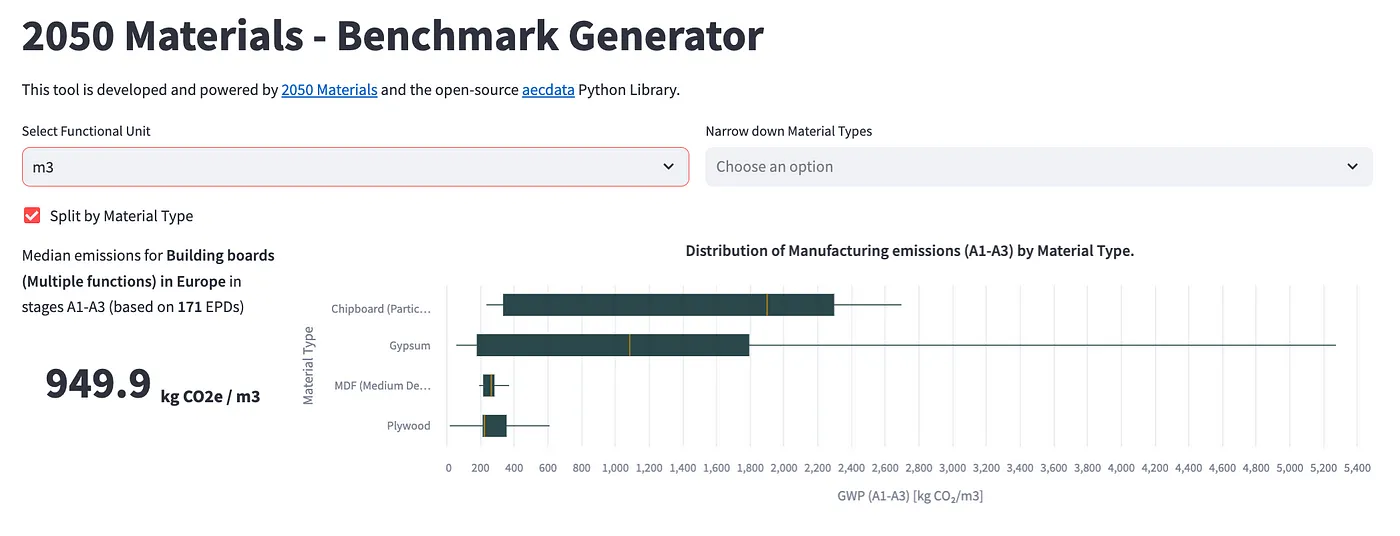Leveraging the Python library AECData for Embodied Carbon Benchmarks

Almost no one knows what is good, bad or great around construction product emission values. Until today, available here
Architects and contractors are constantly seeking ways to incorporate sustainability into their projects. With climate targets becoming more stringent, understanding and managing the carbon footprint of building materials is crucial. This is where 2050 Materials’ API and the open-source Python library, aecdata, come into play. They provide powerful tools to help you develop a custom Streamlit application that can benchmark product emissions efficiently.
Building a Streamlit Tool for Emissions Benchmarking
The Streamlit tool enables users to select a product type and continent, then generate simple graphs showing the quartiles and median emissions within their selection. This functionality is vital for defining default or fallback values in Life Cycle Assessments (LCAs). Additionally, it helps categorize products as good, medium, or bad based on their emissions, providing clear benchmarks for sustainability.
Why is This Important?
- Defining Baselines: Establishing quartile and median emissions benchmarks is essential for determining default values in LCAs.
- Comparative Analysis: Helps architects and contractors understand where a specific product stands in terms of emissions within its category.
- Science-Based Metrics: The first step towards developing metrics that align a product’s carbon footprint with specific climate targets set by nations or individual project requirements.
Key Features of the Tool
- Free Regional Benchmarks Generation: Users can generate benchmarks for four product types without any cost.
- Excel Exports: The tool allows for exporting data to Excel for further analysis.
- Footprint Comparison: Users can compare the emissions of a specific product within the benchmarked range.
- Unlock Full Access: To access all product types, users need to generate an API key from the 2050 Materials platform and input it into the tool.

How it works
- Head to https://2050-materials-benchmark.streamlit.app/
- Select a Product Type and Continent
- Click on “Fetch the data”
- Select the unit and see the boxplot
- (optional) Enter a benchmark to plot the line within the graph


Achieve the Full Potential
To unlock access to all product types, generate an API key from the 2050 Materials platform and input it into the tool.
This will provide comprehensive benchmarking capabilities, enabling a more detailed analysis and understanding of material emissions.
Custom Solutions
2050 Materials also builds custom tools for selected customers. If you are interested in discussing your specific use case, reach out to us at api@2050-materials.com.
You can try the tool directly here.
By leveraging the aecdata library and 2050 Materials’ API, architects and contractors can significantly improve their sustainability practices, making informed decisions based on reliable, science-based data. This tool is just a sample of what can be achieved — start building your sustainable future today.
Interested in getting the full picture on aecdata Python library? Check our previous articles on the topic and learn what you can achieve in under 5 mins.
Related articles

Climate-Resilient Materials for the Built Environment: A Data-Centred Prime
As climate volatility intensifies, resilience metrics are fast becoming as critical as carbon data in material selection. This article outlines why adaptation is now a design imperative, how materials can be evaluated through a systems lens, and what KPIs project teams should demand. From self-healing concrete to fire-rated façades, we present a structured taxonomy of resilient materials, explain how to embed this intelligence into digital design workflows, and propose next steps for specification, benchmarking, and procurement.
Read more
The Most Interesting Low Carbon Products in Office Design
In this article and collection, we highlight 11 outstanding products that contribute to a lower carbon footprint in office design.
Read more
Top Low Carbon Building Boards: Performance, Benefits, and Use Cases
The building boards highlighted in this article and collection showcase low-carbon innovation in modern construction.
Read more